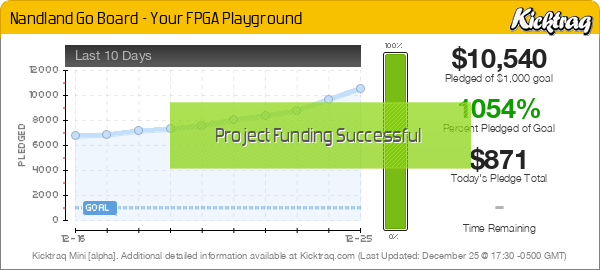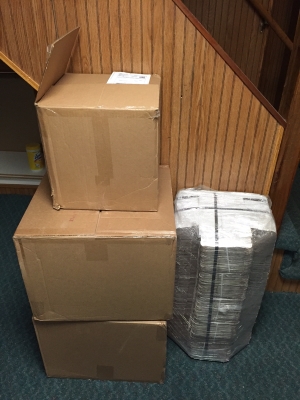The Intricacies in Shipping Kickstarter Products
Published: 2016.03.09

When the Go Board fund raising completed, I was thrilled. With the help of nearly two hundred backers, the Go Board project raised over ten thousand dollars. This exceeded my expectations for the project. The challenge was then to figure out how to produce all of the boards and get them into the hands of the backers as quickly as possible. Prior to launching the Kickstarter campaign, I had read many dire warnings about the costs of shipping products, cautioning eager Kickstarter creators to carefully consider these costs when pricing reward levels. It was good that I built in a buffer to the price of the Go Board, because as you shall see, shipping is not easy or cheap.
The first thing that surprised me was how many backers were from outside the United States. I simply did not realize that Kickstarter was used that much internationally. Nearly 50% of the backers are from outside the United States. I put in a $10 additional charge when creating the project for shipping internationally and I'm very glad that I did this. International shipping is significantly more expensive and complicated than simple domestic shipping.
Printing Your Own Labels
The last thing I wanted to do was to show up to the local post office with 200 boards to ship, having to individually purchase each shipping label. Printing shipping labels at home is a requirement. That left me with a few options:
- USPS (United States Postal Service) Website
- Stamps.com
- PayPal
- Other?
I first started with the USPS website. Unfortunately, there's no way to print international postage at home. See ya later USPS.
Next I looked at Stamps.com. I watched a few videos and tutorials. Stamps.com charges a monthly fee to use their service and their software looks like it has not been updated since 2003. Bye bye to Stamps.com.
I did a little hunting and found that people use PayPal for printing their home postage. You can print your own postage for both domestic and international. You can import addresses from an excel file. But PayPal does not make this service easy to find, it doesn't seem like something they're promoting much. I wouldn't have even known it was there unless I read about it online. I did a little more digging to see what other options I had.
Finally I found a nice looking site called VIP Parcel, a site that looked like it was designed by someone who cares about appearances. One big benefit about VIPParcel was that I could save 10% from normal shipping prices. That's appealing, considering we are talking about thousands of dollars in shipping costs. And I can import addresses and print out many labels at once. Let's get it started in here.
Weight is Key!
The first hiccup that I encountered is that any postage that I print requires a 2D barcode, a 1D barcode, a customs declaration page, in addition to the normal stuff like a source and destination address. This makes the label size 4x7 inches! This is huge! The Go Board itself is only the size of a credit card, but I had to pick packaging that would allow me to put this enormous label on the front of a box.
It wasn't for certain that I was going to use a box. For a while I did entertain the idea of using a padded mailer. There's no discount for padded mailers if they either are greater than 0.5 inches thick or if they are rigid, both of which applied to the Go Board. So they get charged the same price as a box. The main reason that I decided against it was that I didn't want any boards to be damaged in shipping. The main benefit of a padded mailer is that they are lighter weight, and weight makes a huge difference!.
Shipping a package from the United States to Germany costs around $13 when shipping USPS First Class for packages that weight less than 8 ounces. For you non-US folks, 8 ounces is 227 grams, which is almost exactly the weight of a roll of quarters (or 72 pennies). As soon as the package weighs 9 ounces the price nearly doubles to $23 per box! This would have destroyed the cost of the Go Board, so I had to come in under 8 ounces.
As soon as I saw the huge price discrepancy between 8 and 9 ounces, I had to figure out if I was going to make it. But unfortunately I don't have my own scale. So at 11pm on a work night, I had to figure out some way to gauge the weight of the Go Board. Inventory: 4 foot level, a fulcrum, lots of Pennies, a few leftover beers. I nervously packed up a Go Board into a 10x7x3 inch Amazon box. I taped the 72 pennies (8 ounces) to one side of the level and the Go Board in the Amazon box to the other side. Taking a swig of beer for courage, I let the level go... the pennies are heavier! What a relief!

A Box and Other Packing Materials
Just to double check my crude experiment, I drove to the Post Office and weighed it. It came in at 6.8 ounces! Success! As long as I pick a small enough box, it's possible to get the weight down. I finally settled on boxes that are 7x4x2 inches. Now this is a total volume of 56 cubic inches. Since the Go Board was taking up so very little of that space, I had to ensure that it would be save in long distance travels. Let's look for some packing materials!
I found on Amazon that I was able to purchase 7 cubic feet of biodegradable packing peanuts for about $30. Just imagine an enormous garbage bag weighing about five pounds being delivered by your mail delivery human, it was pretty hilarious. And yes, I hate the idea of using plastic for the packing peanuts, so the ones I bought use corn-starch and can dissolve in water, so no worries for the environmentally conscious! Though you could, it's not recommended that you eat the packing peanuts.
So 12x12x12 inches is 1 cubic foot, and 7 cubic feet is 12,096 cubic inches. 12,096 divided by 56 cubic inches per box is 216 boxes, so I should have enough packing peanuts to fill 216 boxes.
I wanted to wrap the Go Boards in an Electro Static Discharge (ESD) safe packing material. I found some ESD bubble wrap bags on eBay and scooped those up. Finally I wanted some business cards to be packaged with the boards because it's nice to get something that reminds you just what the heck arrived at your doorstep.
Adding up the costs!
- $48 - ESD Bubble Wrap Bags
- $28 - Packing Peanuts
- $12 - Packing Tape
- $15 - Business Cards
- $78 - Boxes
- $13 - International Shipping, First-Class USPS
- $3 - Domestic Shipping, First-Class USPS
The total cost of shipping a single Go Board is about $15 for an international shipment and $5 for a domestic shipment. Then include the time it takes to program each board, pack it up, and mail it out, and you can see that shipping takes a lot of time and money. I spent a huge amount of time figuring all of this out, so hopefully I came to the right conclusion. If any of you have any tips or suggestions for ways I could be more efficient in the future please let me know in the comment section below. The moral of the story is do your homework!


